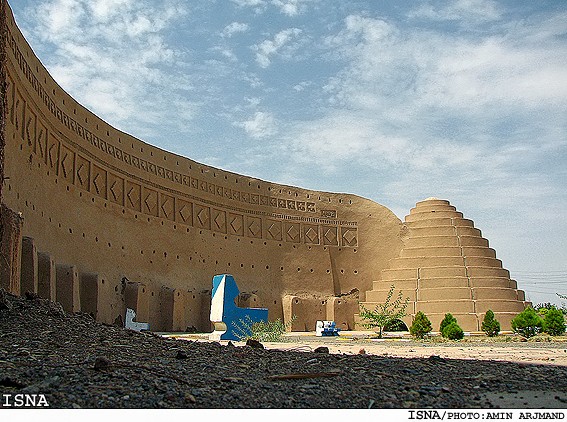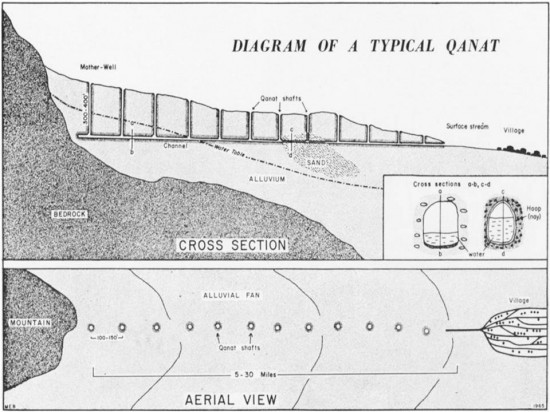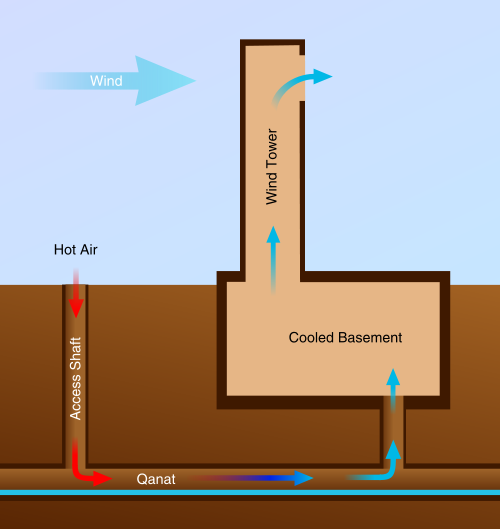
More Than Possible; It’s Probable
What, you want links? Oy, for you I’ve got links!!
http://karakapend.files.wordpress.com/2010/07/qanats-in-the-old-world.pdf
http://www.facstaff.bucknell.edu/mvigeant/univ270_05/jake_aq/aqueducts.htm
http://users.bart.nl/~leenders/txt/qanats.html
http://www.payvand.com/news/09/aug/1245.html
http://www.eartharchitecture.org/index.php?/archives/1045-Yakhchal-Ancient-Refrigerators.html
http://en.wikipedia.org/wiki/Qanat
http://www.saudiaramcoworld.com/issue/200603/the.art.and.science.of.water.htm
http://www.waterhistory.org/histories/turpan/
A nice thought for a hot summer’s day. And while there is no proof of any positive answer to my question, it is certainly possible.
After all, the Egyptians had cows, goats, and sheep ... therefore they had milk and cream. And probably a butter churn, which is really not much more than a couple of cross boards on a stick. The same kind of design as a the paddles in an ice cream maker. They had fruit and spices for flavoring. And not only did they have honey for sweetening, they had locust beans, which are used as a thickener in ice cream today. Locust beans are also known as Carob, and Carob is a chocolate substitute for allergic folks. And dogs. Has been, since always. Vanilla beans come from Madagascar, a bit down the coast. Certainly within trading distance. The Egyptains had some really decent metal working ability, enough to make a copper or a bronze bucket. Or a solid gold one. The observation that salty ice water is colder than plain old ice water is probably as old as time, and with the north end of their country being a sea shore, they certainly had salt.
So they had everything necessary to make ice cream, from the ingredients to the machinery. “Oh no”, you say, “you’re missing the most important thing! It was Egypt. Aegypt!! Hot. Desert. Hot. Sand. Hot. Camels! Did I mention hot? They didn’t have ice!!”
Wanna bet?
See this thing?

Take a guess what it is. It’s a design that dates back to ancient Persia, at least 500 BC. Maybe 1000 BC. Persia; Egypt’s neighbor and occasional conqueror, just a short reed boat ride across the Red Sea away.
So what’s this pile of stone? It’s the ultimate Green Kitchen Accessory. It’s made out of mud brick ... and it’s a giant wind powered refrigerator. An ice box, bigger than a house. One that may have had a built in ice maker, albeit one that only works at night. When it gets really cold in the desert.
I’ve got a lot of reading to do on this, but I wanted to toss the question out to give everyone something new to think about. More fun than reacting to today’s political nonsense, or tomorrow’s, or yesterday’s.
Ok Drew, how would it work?
First off: the air conditioning part. That we know existed, and still exists. Readers from the southwest will be familiar with an old form of A/C called a Swamp Cooler. Evaporative cooling. Blow hot dry air across some water and it cools right down. Take that concept and build it on a massive scale. City size. Several dozen miles long if necessary. But to get there, you’ll need water. Lots of nice, cold water. Here’s your shovel. Start digging.
If you live in a hot dry climate and you need to get water from the spring way over there to your city and farm fields over here, you don’t go and build a canal or an aqueduct. Too much evaporation. No, you build a qanat ("kwaa gnat"). That’s an underground water channel built between a spring somewhere in the mountains and a city somewhere near by. There are tens, if not hundreds, of thousands of the things across the Middle East and the Far East, from Tunisia to Iran to China. They’ve been around for about 3000 years. Most of the water in Iran is still collected this way even today. Digging a water tunnel underground is kind of difficult, so the qanat builders put in an air shaft every 100 feet or so; the lines of these shafts dimple the desert surface by the millions, mile after mile after mile.

Ok, now that you’ve got you qanat built, and your village is getting water ... nice cool water too, from deep underground, but not so deep it starts getting hot again ( about 100 yards or so maximum ). Your tunnel digging slaves have finished, so you cap off the access/air shafts to the qanats. This cuts evaporation to a minimum, and keeps the stupid sheep from falling down the holes.
But you leave one air shaft open. And then you build a building over one of the last air shafts. Make it out of nice heat resistant clay brick, with walls 6 or 9 feet thick. Pretty good insulation right there. Now put a tower on top of the building, with a doorway on the leeward side. A hole in the floor on every level lets air flow from the top of the roof all the way to the basement, all the way down the air shaft, to the cool water flowing in the qanat deep underground.
Except the air doesn’t flow that way. Due to Bernoulli’s Principle, the wind blowing past the tower and past it’s door on the downwind side creates a pressure differential. A partial vacuum. This pulls in hot desert air into the open air shaft (don’t forget to put a sheep filter across it first), and pulls that air underground and across the cold flowing water in the qanat tunnel, and then up into your building. So you get a nice steady cold damp breeze blowing in from the basement. Natural air conditioning.

It works. It’s another ancient design, but largely forgotten by the West. There are lots of these in Spain that still function. You can read all about them, about how they are wonders of Islamic Science from the Golden Age of Islam ... but they aren’t much more advanced than the ones that the Persians built under Sargon I, somewhere around 1000-800 BC. The design was used by the Egyptians, the Greeks, the Romans, and even those barbarians living in Libya. Older than the Profit, may bees pee upon him. Merely copied and brought north by his minions 1000 or so years after it was invented.
Ok, back to our mud refrigerator. Anybody who understands Bernoulli’s principle and the Venturi Effect, or who owns a perfume sprayer, knows that you can pull liquid up a tube with just air flowing across the top of the pipe. See the picture of the big mud fridge and the wall next to it? It’s built above a qanat, and the air shafts run up inside the wall. Really thin ones probably. The wind blows, gets deflected over the top of the wall ... which pulls water up the narrow shafts ... which then runs in a channel near the top of the wall, just like in an aqueduct ... and then flows off the end of the wall onto the spiral stepped surface of the beehive shaped ice box, around and around, cooling the outside. The builders figured out how to make waterproof mud brick (duh, it’s called a kiln, right?), the walls are very thick and well insulated, it gets cooled from the outside by running water all day long, cooled from the inside by evaporative cooling from the subterranean qanat water, and filled with ice or snow gathered during winter. And who knows, perhaps refreshed with any ice made during those cold desert nights. So it IS a giant refrigerator, and it could be an ice maker too.
The one in the picture is about 110 years old, and was built in Sirjan, Kerman Province, in Iran by the first Shah, Pahvli I. The design however is almost as old as Persia.
So it is entirely possible that the Egyptians, always hot to copy a good new idea like the sandal and the horse and the wheel, had these things. Gone now, because even waterproof mud brick doesn’t last forever. And their king, the Pharaoh - at least the later Pharaohs, who spoke Persian or Greek - could have enjoyed a double scoop cone in his cool and moist palace. The technology existed. Mock-chocolate and vanilla flavored.
All I have to do is find some ancient Eastern version of the waffle cone, and my thesis is good to go. ![]()
There are ice cave in Idaho, where in the middle of the high dessert in August, ice is a few feet below the surface.
Posted by Steve_in_CA 07/02/2012 at 04:30 PM
Commenting is not available in this weblog entry.
07/02/2012 at 04:30 PM
Commenting is not available in this weblog entry.
Next entry: Stealth Mode Lost
Previous entry: slag heaps join pyramids as a world treasure says socialist mayor. unesco agrees.